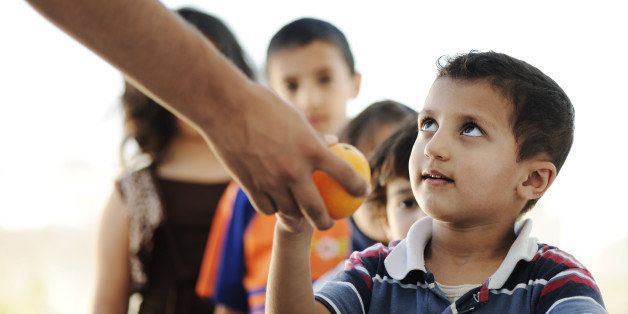
LAS CRUCES -- In just a year, 1,000 extra families lined up at Casa de Peregrinos to get help from the largest food pantry in Las Cruces.
"When you think about it, you think, 'wow.' But it's happening," said Lorenzo Alba Jr., executive director at the pantry. "In November we did see a slight increase in the average -- about 25 more families. We're probably going to see more of it as the year turns."
Casa de Peregrinos and other local hunger relief programs are seeing a surge of new families coming in for emergency food reserves in the wake of cuts to the federal Supplemental Nutrition Assistance Program, or SNAP, which as formerly known as food stamps, Alba said.
On Nov. 1, SNAP benefits dropped after the American Recovery and Reinvestment Act of 2009, President Obama's stimulus program, ended.
Since 2009, the stimulus had provided a 13.6 percent boost in SNAP allotments. With the stimulus expiring, benefits across the nation were reduced to pre-recession levels. The federal program in New Mexico will lose $47 million this year, said Matt Kennicott, a spokesman for the New Mexico Human Services Department.
During the 2013 fiscal year, $678.8 million was spent on SNAP, which serves 444,000 people in New Mexico.
"It's definitely something we'll have to work with and that New Mexican families will have to cope with," Kennicott said. "That's a significant impact on New Mexicans."
For a family of three, these cuts mean $29 less for food every month, dropping the maximum benefit from $497 from $526, he said. The amount of SNAP benefits is based on a family's net income, with the average household benefit of $290 in New Mexico, according to the Pew Charitable Trusts website.
"It will definitely mean they'll have to stretch and reassess their groceries," Kennicott said. "So they may have to look at food banks to help supplement that food for them. $29 a month can mean a lot to a family."
At Casa de Peregrinos, between 950 to 1,100 families stop by for food every month on Mondays, Wednesdays and Fridays. The rural program sees 1,200 to 1,500 people living in surrounding communities and colonias. Most families are on SNAP, Lorenzo Alba said.
"One of the things the families are saying now is that Casa de Peregrinos used to be an emergency food program, and now it's more of a necessity. They actually budget around what we give them," Alba said. "A lot of the families just don't have a choice there, that's just what they have to do."
Poverty and hunger
The national poverty level was at 15.9 percent in 2012, which translates into 48.8 million people living below the poverty line. In New Mexico, 20 percent of the population, or 426,245 people, were below poverty level. That's a slight 1.5 percent decrease from 2011, but it's still the second highest percentage rate in the country, according to the U.S. Census.
In New Mexico, 30 percent of children experience food insecurity, making the state No. 1 in the country for childhood hunger, according to Feeding America's Map the Meal Gap 2011 study. The USDA defines food insecurity as reduced quality, variety or desirability of diet. Very low food security, or hunger, is defined as disrupted eating patterns and reduced food intake.
Almost 17,000 children in Do�a Ana County are food insecure.
New Mexico is also ranked No. 2 in the nation for adult hunger with 20 percent of adults experiencing food insecurity, according to the same study.
It's impossible
Among other criteria, being at or below the poverty level qualifies a person to participate in SNAP. About 81 percent of people in New Mexico who are eligible for SNAP are in the program, according to the Roadrunner Food Bank.
Roadrunner Food Bank is the state's largest nonprofit hunger relief organization. The group distributed more than 26 million pounds of food to local food banks and nonprofit programs throughout the state last year. The southern New Mexico branch in Las Cruces is two years old and distributed 4.5 million pounds of food last year to southern counties. Public donations and federal aid to the food bank help feed nearly 40,000 people every week, said Melody Wattenbarger, CEO of the organization.
"It isn't good for society to have such a large number of people without proper nutrition," she said. "SNAP is the basic food safety net in our country and any cuts for that drive up demand. These cuts that are being proposed -- the number that we're hearing, they're so massive. There's just no way that private sector food programs, like Roadrunner Food Bank, can ever hope to meet that need. We won't be successful in filling that gap."
The Federal Agriculture Reform and Risk Management Act, otherwise known as the farm bill, is currently being negotiated in the House of Representatives after the Senate approved an earlier version that would cut about $4 billion from SNAP over a decade.
In the White House
"The House (farm) bill will cut over $40 billion from the SNAP program," Udall said in an interview. "So what you're talking about is cutting 32,000 New Mexicans off the program if you do that."
About 40 percent of people on SNAP are children and 13 percent are seniors. More than half are working families, he said.
"I can't stand by and accept cuts to a program that's helping feed almost a quarter of New Mexicans, especially when New Mexico leads the nation in child hunger," he said. "I'll fight against these cuts in my roll on the Senate appropriations agriculture subcommittee."
Congressman Steve Pearce, who represents southern New Mexico, has a different view and has voted twice in favor of the House version of the farm bill. He said the bill's measures will protect SNAP through reforms that will deter people from abusing the program while saving taxpayers billions of dollars, including the $40 billion reduction from SNAP.
"New Mexicans who rely on SNAP will benefit from the changes, which make the program more secure for future generations and restore elements of the program designed to help people get back on their feet," Pearce said in an email.
Abuse and stigma
Betty Angel said she stopped working because of several medical conditions, including heel spurs, hypertension and depression from losing a son. She's been getting food aid for two years. She hesitated to give her name to the Sun-News because she knows other people can have harsh views about people on SNAP.
"With the recent cut, they cut me down," she said. "While I was working, I wasn't making it either."
Before Nov. 1, she used to get about $200 to buy food. Now she gets a little over $100, she said.
"I'd rather be working than asking for help. It drives me crazy being here at home," she said. "I don't abuse the system and I'm against a lot of that. I don't want to criticize nobody, but I have seen other people abuse food stamps."
There are two forms of recipient abuse the USDA tracks: trafficking, in which recipients sell their food stamp benefits for cash, or lying on applications to get more benefits than they are entitled to. According to the USDA, abuse has dropped significantly in the past two decades with tougher oversight. The USDA website said the trafficking rate dropped from about 4 cents on the dollar in 1993 to about 1 cent in 2006-08, the latest figure available.
Andi Murphy may be reached at 575-541-5453. ___
(c)2014 the Las Cruces Sun-News (Las Cruces, N.M.)
Visit the Las Cruces Sun-News (Las Cruces, N.M.) at www.lcsun-news.com
Distributed by MCT Information Services
